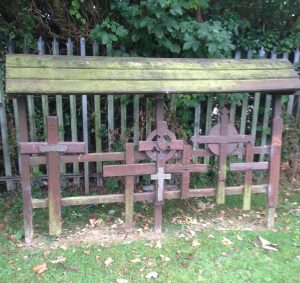A special event took place last week at Pittville School to celebrate the completion of a project to conserve and restore over 20 wooden WW1 battlefield crosses. The crosses had been subject to the elements for a number of years on display at the entrance to Cheltenham Cemetery. They have now been restored and preserved for future generations.

This project has been coordinated by the Cheltenham Civic Society and funded by the National Lottery Heritage Fund.
WW1 soldiers were usually buried near to where they fell and a simple wooden cross was erected to mark the location. Often these crosses were handmade by comrades and friends using materials that were to hand at the time. During the war and for many years after a huge project was undertaken to identify the isolated graves scattered across battlefields, replace the grave markers and eventually re-inter the men in mass military cemeteries with official headstones.

In 1920 the Gloucestershire Echo reported:
“It had been suggested by many residents that the Cheltenham Remembrance Day Association should undertake the placing in position (at Cheltenham Cemetery) and after-care of the wooden crosses temporarily placed over the graves our fallen townsmen France and elsewhere. These crosses are being replaced in the cemeteries in France with permanent memorial stones and the crosses will dispatched by Government to the next of-kin of the deceased if application is made for them the Imperial War Graves Commission”

For local families who had sons, husbands or fathers buried overseas this was hugely important, as most would never have the opportunity to visit the war graves overseas or have a funeral for their loved ones. The wooden crosses were mounted on rails in the entrance to Cheltenham Cemetery, Bouncers Lane. By 1928 around 230 had been returned in total, but today only 22 remain.
Pupils from Pittville School have been researching the men whose names are on the crosses and displayed their findings at the launch event. You can read more about the men they researched and about the conservation process in the free downloadable booklet created about the project.

Leave a Reply